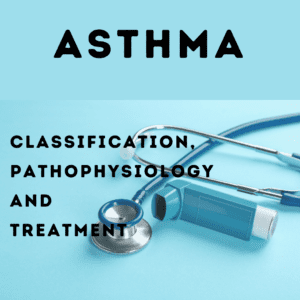Asthma: Classification, Pathophysiology and Treatment
The article will help you to explain briefly every aspect of asthma. Let’s start with Asthma: Classification, Pathophysiology and Treatment

DEFINITION:
Asthma is a chronic inflammatory disease of the airways that is characterized by chronic airway inflammation and increased airway hyperresponsiveness toward various stimuli leading to symptoms of wheezing, cough, chest tightness, and dyspnoea.
CLASSIFICATION OF ASTHMA:
ATOPIC ASTHMA:
- Begins in childhood.
- Family history is common. Asthmatic attacks are often preceded by allergic rhinitis, urticaria, or eczema.
- A skin test with the antigen results in an immediate wheal-and-flare reaction, a classic example of the type I IgE-mediated hypersensitivity reaction.
- Extrinsic (Allergic) Triggers: Dust, mites, Mould, Certain foods, Animal dander, Pollen.
NON-ATOPIC ASTHMA:
- In asthmatic subjects, the bronchial response, manifested as spasm, is much more severe and sustained.
- Positive family history is uncommon.
- Serum IgE levels are normal.
- There are no associated allergies.
- Viral infections of the respiratory tract (most common) and inhaled air pollutants such as sulfur dioxide, ozone, and nitrogen dioxide are the common causes.
- Virus-induced inflammation of the respiratory mucosa lowers the threshold of the subepithelial vagal receptors to irritants.
- The ultimate humoral and cellular mediators of airway obstruction (e.g., eosinophils) are common to both atopic and non-atopic variants of asthma.
- Intrinsic (Non-Allergic) Triggers: Exercise, Infections (cold and flu), Cold or humid air, Intense emotions (ex. Stress), Medications (aspirin), Hormones, Air pollution, Fragrances and chemicals, Occupational irritants.
ETIOLOGY & TRIGGERS: Asthma: Classification, Pathophysiology and Treatment
- Genetic factors.
- Allergen exposure: house dust mites, household pets, grass pollen Atmospheric pollution: sulfur dioxide, ozone, cigarette smoke, perfume.
- Dietary deficiency of antioxidants: Vit-E and selenium may protect asthma in children(fresh fruits and vegetables).
- Occupational sensitizers: Isocyanates(from the industrial coating, spray painting).
- Drugs: NSAIDs, B-blocker.
- Cold air.
- Exercise.
- Emotion.
PATHOPHYSIOLOGY:
Asthma is a disease characterized by airway inflammation and episodic, reversible bronchospasm. It has two characteristic features:
1) Inflammatory changes in the airway.
2) Bronchial hyperreactivity to stimuli.
- Antigens (pollen and house-dust mites) sensitize patients by stimulating the production of IgE-type antibodies, which remain either circulating in the blood or become attached to the mast cells of nasal or bronchial tissues and basophils.
- On re-exposure, to the same antigen, the resulting antigen-antibody reaction in the early phase causes degranulation of the lung mast cells and releasing of the powerful bronchoconstrictor such as histamine, 5-HT, PGD2, and cysteinyl leukotrienes (LTB4, LTC4, and LTD4).
- Lung mast cells also release ILs (IL-4, IL-5, and IL-13).
- In the late phase of asthma, these mediators activate other inflammatory cells (eosinophils, basophils, and alveolar macrophages) which also release LTs and ILs.
- Other mediators of inflammation, in the delayed phase, are adenosine (causing bronchoconstriction), neuropeptides ( causing mucus secretion and increase in vascular permeability, etc.
- The normal tone of bronchial smooth muscle is influenced by a balance between parasympathetic, sympathetic, and non-adrenergic–non-cholinergic (NANC) mediator’s activity.
CLINICAL FEATURES:
Symptoms of asthma:
- Coughing.
- Wheezing.
- Dyspnoea.
- Shortness of breath.
- Chest tightness.
As per the severity of the attack; it is classified as:
Mild asthma attack: Asthma: Classification, Pathophysiology and Treatment
- Cough.
- Wheezing.
- Mild difficulty breathing during normal activities.
- Difficulty sleeping.
- The peak expiratory flow rate (PEFR) is 70 to 90%.
Moderate asthma attack:
- Severe cough.
- Moderate wheezing.
- Shortness of breath.
- Chest tightness.
- Usually worsens with exercise.
- Inability to sleep.
- Nasal congestion.
- PEFR is 50 to 70 %.
Severe asthma attack:
- Severe wheezing.
- Severe dyspnoea.
- Inability to speak in complete sentences.
- Inability to lie down.
Signs:
- Rib retractions: ribs are visible during each breath.
- Nasal flaring: nostrils open wide during each breath.
- Use of accessory muscles: neck muscles are prominent during each breath.
- Chest pain: Sharp, chest pain when taking a breath, and coughing.
DIFFERENTIAL DIAGNOSIS
- PEFR is <50%.
- Confusion.
- Rapid pulse.
- Fatigue.
- Tachycardia.
- Hyper-resonant percussion note.
- Expiratory rhonchi, expiration>inspiration.
SILENT CHEST: No findings when asthma is under control or b/w attacks.
INVESTIGATIONS: Asthma: Classification, Pathophysiology and Treatment
Lung function tests/ pulmonary function tests:
- Spirometry– estimate degree of obstruction – ↓FEV1, ↓FEV1/FVC, ↓PEF.
- Blood tests: shows an increase in the number of eosinophils in peripheral blood.
- Sputum tests: It is a more useful diagnostic tool showing the presence of large numbers of eosinophils in the sputum.
- Chest X-ray: There are no diagnostic features of asthma on the chest X-ray. It may be helpful in excluding a pneumothorax, which can occur as a complication of asthma.
- Skin-prick tests (SPT): They should be performed in all cases of asthma to help identify allergic causes.
Asthma: Classification, Pathophysiology and Treatment
DIFFERENTIAL DIAGNOSIS:
- Chronic obstructive pulmonary disease (COPD).
- Congestive heart failure.
- Pulmonary embolism.
- Laryngeal dysfunction.
- Mechanical obstruction of the airways (benign and malignant tumors).
- Pulmonary infiltration with eosinophilia.
- Diffuse parenchymal lung diseases.
- Vocal cord dysfunction.
COMPLICATIONS:
- Pneumonia (infection of the lungs).
- Respiratory failure.
- Status asthmaticus.
- Pneumothorax.
MANAGEMENT OF ASTHMA:
Aim:
- Maintain pulmonary function as close to normal as possible.
- Avoid adverse effects from asthma medications.
- Prevent asthma mortality.
General Measures: Asthma: Classification, Pathophysiology and Treatment
- Advice diets are higher in vitamins C and E, magnesium, and omega-3 fatty acids.
- Avoid seafood that may become allergens.
- Exercise: short, intermittent periods of exertion.
- Stop smoking.
- Reassure the patient, as anxiety worsens respiratory distress.
- Keep the patient in an upright position.
Medicinal Therapy:
- Start oxygen 50-60 % initially, and continue until the patient is better and not dyspnoeic.
Nebulized with salbutamol or Terbutaline for immediate relief. Salbutamol 5 mg (1 ml with 1 ml normal saline) stat. Repeat the dose at 15 mins if required during the first hour. Hourly for the next few hours till the bronchospasm is controlled. - Secure I/V Inj. Hydrocortisone 200mg I/V stat routinely given to all severe cases than 6 hourly.
- Antibiotic if there is evidence of infection.
- Adequate hydration and mucolytics.
Asthma: Classification, Pathophysiology and Treatment
HOMOEOPATHIC MEDICINES:
- Arsenic album.
- Spongia Tosta.
- Blatta Orientalis.
- Sambucus nigra.
- Nux vomica.
- Antimonium Tart.
- Dulcamara.
- Natrum sulph.
Follow us:

More to study:








1 thought on “Asthma: Classification, Pathophysiology and Treatment”